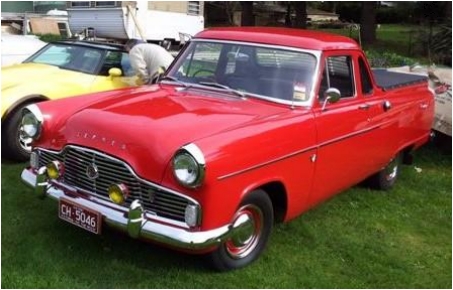THE BIRTH OF THE “UTE”
Country areas and country pubs have rung with conversations about the ubiquitous utility truck for nearly half a century. The “ute” is an Australian term of endearment for a vehicle that came into existence in Australia in 1934 and the rest of the world gradually took up the design and incorporated it into their range. The utility concept was first suggested by a farmer who wrote to ask the Ford Co. in Geelong. ”Why don’t you build people like me a vehicle in which I can take my family to Church on Sunday and my pigs to town on Monday?”

The year was 1933 and the reason behind the request for a dual-purpose vehicle is explained by the fact that Australia was then in the depths of depression and the purchase of one such vehicle would be far easier on the farmer’s finances than the purchase of a separate vehicle for each purpose.
The letter was addressed to the managing director, from whom it was circulated to the sales department, finance department, and then to the production department, where the production dept. referred it to the chief body engineer, who in turn asked the body designer if such an unlikely sounding vehicle was feasible. However, once the body designer, Mr. Lewis T. Bandt, put the idea down on paper, he found the result was a surprisingly well-balanced vehicle.
Mr. Bandt had joined Ford in 1929 from Adelaide after completing a fitting and turning course while employed on custom-building design with a South Australian company. He later completed a correspondence course in body design, including 8 months on Ford work with an American company.
The coupe utility vehicle was the first of its kind, being a dual-purpose vehicle which was to open new markets around the world. It was originally labelled a “light delivery” vehicle when tested on the road in 1934 and subsequently released later in the year, and was an immediate success. The passenger compartment contrasted dramatically with the draughty halfdoor or doorless T-model delivery trucks, vans and buckboards of that era. It offered farmers and tradesmen personal transportation with passenger car comforts, and a handy cargo space all in one unit. It also shuts out the unpleasant smells of fertilisers and farm stock from the driving compartment.

It is remarkable today how well the original design has endured, with very little in the way of advanced improvements being made on the original concept. It has been said many times that necessity is the mother of invention, and in the case of the utility vehicle in Australia’s motoring history, the adage is true. However, it was also necessary to invent a description for the radical vehicle, and the word “ute” which was inserted into the English language when the vehicle was designed has endured as well as the vehicle itself.
Compliments...Ed Bourke

